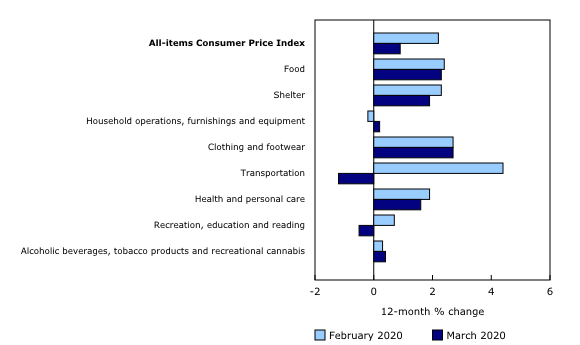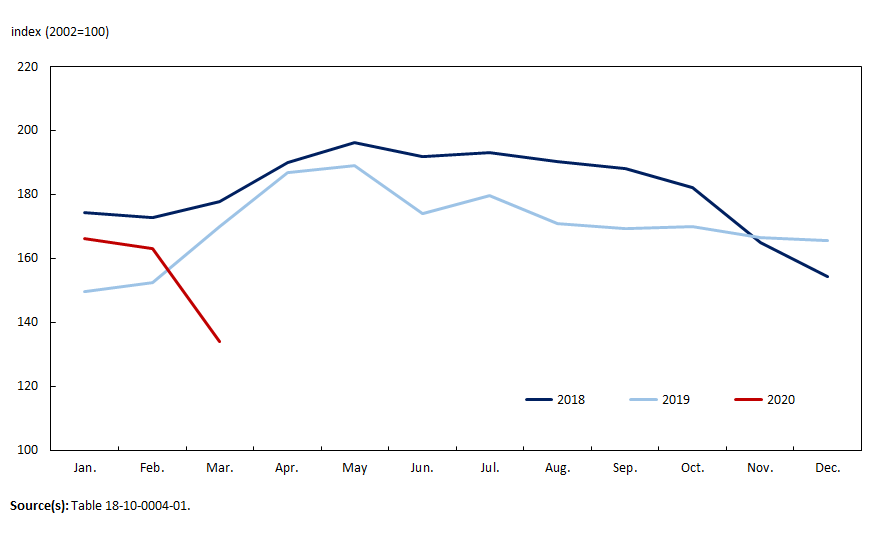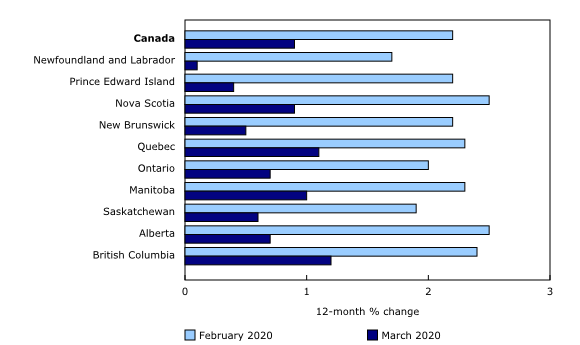Consumer Price Index, March 2020
Archived Content
Information identified as archived is provided for reference, research or recordkeeping purposes. It is not subject to the Government of Canada Web Standards and has not been altered or updated since it was archived. Please "contact us" to request a format other than those available.
Released: 2020-04-22
March 2020
0.9% 
(12-month change)
The Consumer Price Index (CPI) rose 0.9% on a year-over-year basis in March, down from a 2.2% gain in February. Year over year, consumer price growth decelerated the most since September 2006, as global economic activity continued to slow due to the COVID-19 outbreak. Excluding energy, the CPI rose 1.7%.
On a seasonally adjusted monthly basis, the CPI fell 0.9% in March, the largest decline in the seasonally adjusted CPI since its inception in 1992. Excluding food and energy, the seasonally adjusted CPI rose 0.1%.
Highlights
Prices rose in six of the eight major components on a year-over-year basis, with shelter prices (+1.9%) contributing the most to the all-items increase. Consumers paid less for transportation (-1.2%) and recreation, education and reading (-0.5%) compared with March 2019.
Energy prices drop on lower demand and higher supply
Energy prices fell 11.6% on a year-over-year basis in March, driven by the largest one-month price decline since November 2008. Compared with March of last year, consumers paid 21.2% less for gasoline, stemming from low crude oil prices, which also resulted in lower prices for fuel oil and other fuels (-9.5%) and fuel, parts and accessories for recreational vehicles (-18.5%).
Crude oil prices fell in March as a result of lower demand as global economic activity, trade and travel slowed in response to the COVID-19 outbreak, as well as an oversupply of oil amid tensions between oil-producing nations. The year-over-year decline in energy prices was accentuated by an increase in gasoline prices in March 2019, when crude oil prices began to recover from a sustained supply glut, which has fallen out of the 12-month movement.
Consumer prices for durable goods rose 0.3% year over year in March, after a 1.1% gain in February. Year-over-year growth in the purchase of passenger vehicles index slowed to 1.0% from a 2.2% gain in February, attributable, in part, to higher incentives for customers and lower availability of new model-year vehicles compared with March 2019.
Year-over-year growth in service prices slows amid COVID-19
Year-over-year growth in service prices slowed to 2.0% in March, following a 2.2% gain in February. Much of the slowdown stemmed from services impacted by travel advisories and flight suspensions aimed at reducing the spread of COVID-19. Prices for travel tours (+1.0%) and air transportation (+6.0%) rose less in March than in February as a number of international trips became unavailable to consumers. Lower year-over-year prices for traveller accommodation (-2.2%), rental of passenger vehicles (-6.4%) and rail, highway bus and other inter-city transportation (-4.6%) reflected reduced demand for travel within Canada. These movements coincided with increasing emphasis on physical distancing, including the cancellation of major events and advisories against non-essential travel.
Regional highlights
On a year-over-year basis, prices rose less in March than in February in every province, led by lower prices at the gas pump. Price growth slowed the most in the Atlantic region, where furnace fuel oil is commonly used for home heating. Consumers paid less for fuel oil and other fuels as a result of low global oil prices.
Energy prices fall in Alberta and Ontario
Consumers in Alberta paid 21.1% less for natural gas compared with March 2019, when natural gas prices rose in response to colder-than-expected weather. In March, lower consumer prices reflected a decline in commodity prices around the world. As with other energy products, the COVID-19 pandemic resulted in lower demand for natural gas, while inventories remained high.
In Ontario, electricity prices declined 1.4% on a year-over-year basis, largely due to changes to the province's time of use electricity rates. On March 24, following the mandatory closure of non-essential businesses in Ontario in an effort to limit the spread of COVID-19, the provincial government suspended time of use rates. This measure resulted in residential customers being billed at lower, off-peak rates at all hours.
Consumers pay less for traveller accommodation in Alberta
While prices for traveller accommodation declined in most provinces, prices decreased the most in Alberta (-10.8%), largely influenced by lower demand as a result of limited tourism to Rocky Mountain resort towns.
Year-over-year Consumer Price Index growth slows at a pace unseen since 2006
In March, headline CPI growth slowed to a 0.9% gain, following a 2.2% increase the previous month. This was the largest year-over-year deceleration in the growth of consumer prices since September 2006.
COVID-19 and the Consumer Price Index
Statistics Canada continues to closely monitor the impacts of the novel coronavirus (also known as COVID-19) on Canada's Consumer Price Index (CPI).
Price collection for the March CPI was largely unaffected by the COVID-19 pandemic, as the majority of prices were collected prior to the implementation of local travel limitations. Statistics Canada has, where necessary, adopted measures to reflect the limitations faced by Canadian consumers.
In March, several international flights were suspended indefinitely in an effort to limit the spread of COVID-19. Although information on airfares was collected prior to the suspension of flights, these flights are excluded from the March CPI calculation because passengers were ultimately unable to consume these services.
As with airfares, prices for travel tours were collected in advance of the advisories against non-essential travel, announced on March 13. Prices for travel tours taking place after this point are imputed from a higher level index (travel services).
Traveller accommodation prices were also collected in advance, prior to the closure of the Canadian border and advisories against non-essential travel. Additional prices were collected towards the end of the reference period to ensure the price movement is representative of the consumer experience across the entire reference period. The published price movement represents an average of all collected prices for the reference period.
Two ways of exploring the Consumer Price Index (CPI)
Visit the Consumer Price Index Portal to find all CPI data, publications, interactive tools, and announcements highlighting new products and upcoming changes to the CPI in one convenient location.
Check out the Consumer Price Index Data Visualization Tool to access current and historical CPI data in a customizable, visual format.
Note to readers
For the March reference month, 99.8% of collection for the Consumer Price Index (CPI) was completed as scheduled prior to the closures of non-essential businesses.
Treatment of air transportation and travel services in the March CPI
Price collection for the March CPI was largely unaffected by the COVID-19 pandemic, as the majority of prices were collected prior to the implementation of closures and local travel limitations. Statistics Canada has, where necessary, adopted measures to reflect the experience faced by Canadian consumers.
In March, several international flights were suspended indefinitely in an effort to limit the spread of COVID-19. Although information on airfares was collected prior to the suspension of flights, these flights are excluded from the March CPI because passengers were ultimately unable to consume these services.
Prices for travel tours were collected in advance of the advisories against non-essential travel, announced on March 13. Prices for travel tours taking place after this point are imputed from a higher level index (travel services). Because Canadians are unlikely to have travelled internationally after these travel advisories were issued, this intervention ensures that the published price movement reflects trips that were taken during the first half of March.
Traveller accommodation prices were also collected in advance, prior to the closure of the Canadian border and advisories against non-essential travel. Additional prices were collected towards the end of the reference period to ensure the price movement is representative of the consumer experience in March. The published price movement represents an average of all collected prices for the reference period.
Cellular services index
The cellular services price index is now available upon request. For more information, contact us (toll-free 1-800-263-1136; 514-283-8300; STATCAN.infostats-infostats.STATCAN@canada.ca).
Real-time data tables
Real-time data table 18-10-0259-01 will be updated on May 4.
Next release
The Consumer Price Index for April will be released on May 20.
Products
The Consumer Price Index Data Visualization Tool is available on the Statistics Canada website.
More information about the concepts and use of the Consumer Price Index (CPI) is available in The Canadian Consumer Price Index Reference Paper (62-553-X).
For information on the history of the CPI in Canada, consult the publication Exploring the First Century of Canada's Consumer Price Index (62-604-X).
Two videos, "An Overview of Canada's Consumer Price Index (CPI)" and "The Consumer Price Index and Your Experience of Price Change," are available on Statistics Canada's YouTube channel.
Contact information
For more information, or to enquire about the concepts, methods or data quality of this release, contact us (toll-free 1-800-263-1136; 514-283-8300; STATCAN.infostats-infostats.STATCAN@canada.ca) or Media Relations (613-951-4636; STATCAN.mediahotline-ligneinfomedias.STATCAN@canada.ca).
- Date modified:









